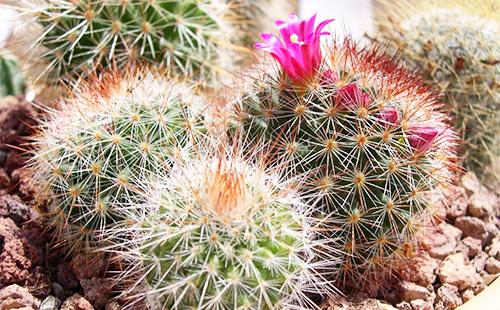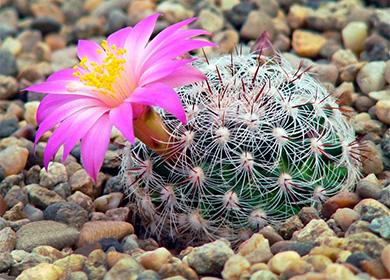The content of the article
For the first time this genus of the Cactus family became known in 1753. The plant was described by the Swedish botanist Karl Linney. Continued acquaintance with the genus and its species, a researcher from Britain Adrian Haworth. Over time, professional breeders have bred a lot of varieties.
The name comes from the Latin word mammilla, which means "nipple". The presence of characteristic tubercles is a hallmark of these plants.
Description
The birthplace of cacti is Mexico. Today, you can meet them not only in this country, but also in southwestern American spaces, West Indian, Colombian, Venezuelan, Guatemalan, Honduran lands. The plant is adapted to hot and dry climates.
In most cases, cacti are small in size. Their elongated or flat stems are presented in the form of a ball, disk. The diameter is up to 20 cm, and the height is up to 40 cm. They can grow both separately and in a "flock." Ribs, unlike most relatives, they do not. Instead, there are nipples of various shapes.
Thick and fleshy roots. Plant flowers can be represented in the form of bells, tubes, flat circles. They differ not only in size, but also in shades of flowers - from white to red, purple.
Indoor Varieties
The genus has about 160 species. In home floriculture, not all are used. A number of the most common plants are presented in the table.
Table - The main "domesticated" types of mammillaria
| View | Features |
|---|---|
| Bauma | - Rounded shapes; - white spines; - flowers of bright straw color; - often grows in a "flock" |
| Elongated | - Stems are not thick; - neat outlet; - thorns of a golden hue; - shallow abundant flowering |
| Wild | - Spikes-hooks of a golden hue; - yellow flowers with a straw hue |
| Prickly | - The stem in the form of a ball; - thin, sharp, white spines; - bright pink flowers; - strong branching; - a large number of children |
| Superior | - A thick stem in the shape of a ball; - small spines of white color; - flowers of pink, red color |
| Zeilman | - A thick stem in the form of a cylinder with branches; - densely planted thorns (bent); - purple, white or pink flowers; - flowers form a circle |
| Ghana | - A thick stem in the shape of a ball or cylinder; - white hairs; - pink flowers |
| Bokasskaya (Bokasanskaya) | - Large, slightly elongated stem; - trunk with branches, silver; - brown central spine; - the remaining spines are long, fluffy and white; - small white flowers in large numbers |
| Runaway | - Low thin stalk; - fluffy, sharp, white, and in the center are golden spines; - small white flowers |
| Gracilis | - The plant has the shape of an inverted pyramid; - large white or yellowish flowers |
Basic care
The plant is able to grow in almost any conditions. It is not difficult to take care of him, but you need to try a little and provide the thorny pet with maximum comfort.
Location and lighting
Photophilous cactus is best placed on the southern, eastern window sills and closed terraces. The lack of lighting leads to its deformation, loss of decorative properties, lack of flowering. Avoid direct direct exposure to ultraviolet radiation. On especially hot days, we obscure the plant. Views with lush spines require most of the light.
Starting from spring, we take out the pot on the veranda, balcony. We do not do this at low temperatures, avoid precipitation. In winter, we use artificial lighting and extend the daylight hours to 14-16 hours, especially when flowering occurs. Replacing a place during dormancy is not recommended.

Temperature
In the cold season, for varieties without fluff, a regime of 7-14 ° C is suitable, for pubescent - 15 ° C. Cool content allows the plant to relax and gain strength. The rest of the time, the temperature can be high, since the cactus copes with heat, drought. Ideal conditions are a mode in 20-23 ° C.
Humidity and watering
Since the cactus tolerates dry climates well, there are no special moisture requirements. It is better to spray it in the summer, and in winter this is not necessary. We use a small spray gun. We humidify the air in the early morning or evening. In parallel, we clean the plant from dusty and dirty plaque.
In winter, mammillaria should be watered no more than once a month. We take such an amount of water that only wet the top layer of soil. Starting in May and ending in June, we adhere to an abundant watering regime. Schedule - once every eight to ten days. We take into account weather conditions, indoor air temperature. From the end of summer to October, we gradually reduce the amount of water (maximum twice a month).
Soil and top dressing
It is recommended to use loose soil, which passes air and moisture well. You can take both store products for cacti and self-made. It is supposed to use a mixture of turf, peat, leaf soil (one part). Sand and crumb from a brick, a shell rock (in half of one part) are added to it.
The plant needs recharge only from spring to autumn. You can feed with complex mixtures from the store, intended for succulents. We bring them in once a month. From the end of autumn and in spring we do not use fertilizer. Before dressing, carefully study the manufacturer's instructions. For greater convenience, we take products that are soluble in water.
Transplant and pot
A young cactus is transplanted every year, an adult - once every three years. The best time is spring. We apply the transshipment method. We move the plant to a new flowerpot with an old soil lump. We do not touch the roots, as they are quite fragile. First of all, there is a drainage layer, then a soil mixture. The soil must be dry.
We give preference to flowerpots made of plastic. The capacity for the cactus should be wide and shallow. There must be a drainage hole through which excess fluid will drain.
Before transplanting, the plant is placed in a shaded place. The cactus adapts to new conditions for several days, so we water it a little later.
Breeding
Cactus propagates by seed or lateral shoots. Reproduction by children over time leads to the loss of species characteristics, degeneration of the plant.The seed method is less convenient, but it must be periodically used to renew the plant.
Seeds
Features. The method allows you to get several young cacti. We collect seeds ourselves from ripened fruits or buy in a store.
Action algorithm
- Soak the seeds in a solution of potassium permanganate. We make it a weak concentration and get a light pink tint.
- Sow in moist soil, sprinkle a little.
- We build a greenhouse: we cover the container with polyethylene film or glass.
- Periodically sprayed.
- Remove the polyethylene or glass when spikes appear.
- We plant in permanent flowerpots.
Side shoots
Features. To vaccinate children successfully, we use stimulating store products for active growth. We carry out the procedure in May-August. We put on gloves to avoid scratches.
Action algorithm
- Cut the shoots located closer to the base. We dry the cut place for several days in the air.
- Plant shoots, water a little.
- We provide suitable conditions: ambient light, 22-25 ° C, watering after the soil has completely dried.
- The root system is formed within three to four weeks.
Pests
Most problems in the plant arise due to an excess of moisture, improper watering. Also, their appearance is affected by the inappropriate microclimate.
The cactus is affected by the following pests.
- Shield. Small scales appear on the stem. Insects suck the juice from the plant, which leads to its weakening. Treatment is with insecticides. In addition to them, folk remedies are used. It is necessary to wash the pot, window sill or the place where it stands with a solution of soap. We spray the plant with it, after covering the soil.
- Red tick. Appears as a result of an excess of moisture. The main manifestations with a weak lesion: an almost invisible web, creating a gray coating. Yellow spots appear on the stems, which gradually become brown. An urgent need to be treated with an insecticide. It is better to do this in at least three approaches, keeping between them for a week. Among folk remedies, an infusion ofdandelions (30 g of roots per 1 liter of water), garlic (200 g per 1 liter of water), onion (15 g per 1 liter of water).

Disease
The plant is also susceptible to a number of diseases that often appear as a result of improper maintenance.
- Phytophthora. Infectious disease caused by fungus. Stems or roots begin to rot. We remove the affected areas with a knife. With root rot, transplant the cactus into a new pot. We treat the places of cuts with fungicides, sprinkle with charcoal.
- Fusarium. Appears in a cold, waterlogged microclimate, in poor lighting. We remove the affected areas, treat them with fungicides. In case of severe damage, we transplant into a new soil, previously sterilized.
- Root nematode. Reasons: infected, poor-quality soil. It is very difficult to notice, as it spreads to the roots. Bubbles appear. They need to be cut. Keep the roots in hot water for no more than ten minutes. Dry them and sprinkle with charcoal. We transplant into new soil.
Cactus can be used in the creation of florarium. A small glass greenhouse will be the highlight of the interior.

